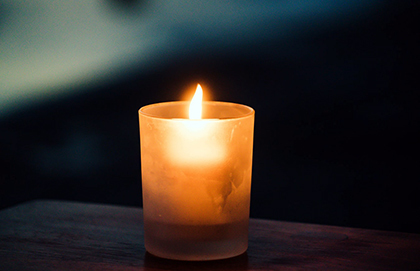This is the second article of a weekly series of Advent reflections. To read the first piece, please click here: An Advent(ure) of the Heart.
The people who walked in darkness have seen a great light; those who lived in a land of deep darkness, on them light has shined. (Isaiah 9:2)
It seems fitting that the first week of Advent, when each early-winter day seems exponentially shorter than the last, signifies hope. As we light the first candle on the Advent wreath, I’m reminded of how dark and dreary these days can be, and yet how much light a single candle sheds in the darkness. Powerful as it may seem, the darkness cannot overcome the light of one small purple candle.
This darkness can feel dismal, as the weeks stretch on and the days get shorter. But, as Advent is a season of preparation, we can find strength in the dark days to remember that this, too, is a time well worth living and pursuing. I wrote last week that there is a purpose for Advent, a reason enough for living in the “now” — but when the darkness seems stronger and the days grow shorter, the four-week preparation can feel a gruelling task. Particularly as the blaring Christmas music (all the noise, noise, noise!) and holiday commercials seem as loud as ever.
But as Isaiah declares, the people who walked in darkness have seen a great light. The light will shine, as we know it does each year. This first week of Advent, we can be reminded of the hope that comes with light. It’s a small light, and the hope might be small, but it’s there, breaking through the encompassing darkness. Jesus Christ, Himself, is this light. I’m reminded of this small, sure light, when I see twinkle lights in my frosted front window, breaking through the dark afternoon skies. I see this light when I see the falling snow, bringing a soft, white brightness to the ground on the dark, grey days. There is light around, just as sure as the darkness is present.
As I said last week, we often want to skip ahead to Christmas, refusing to face the darkness. But we would be mistaken to waste this time of preparation and dig our heels deep into whatever ground the dim light in front of us illuminates, grasping for a semblance of something, anything, to avoid the darkness. It would be easy to, once we find any small bit of light, hold onto it with every effort inside of us, still attempting to fast-forward through the dark. This time of year, I think, is about finding a delicate balance between light and darkness. Our days are not as long as they once were in the summer, but they are not entirely pitch-black.
We can see this darkness and choose to ignore it, or we can remember that while the darkness exists, it can never encompass the glimpses of light, of hope to come.
I learned recently that darkness serves an important role in the growth of poinsettias. These plants must have continuous long nights before they are able to flower into the bright, beautiful red Christmas plants that often surround churches during the Nativity. They need about two weeks’ worth of consecutive nights to bloom fully. Too little light and the poinsettia won’t transform into its vibrant scarlet coat. Too much darkness, though, and the plant won't survive, either.
We can learn something from poinsettias. Advent (or Jesus, really) doesn’t ask us to remove all light from our surroundings and throw ourselves into a pit of darkness, despair and dread. Jesus will come at Christmas, after all, and the light is something worth looking for. The Advent wreath, lit now with one candle, reminds us that He will surely come, and we will, in a few weeks, see a great light. But for now, maybe the current amount of darkness isn’t so bad. Maybe the darkness can help in the preparation for seeing the light.
As a kid, one of the rudest ways to be woken up (in my humble child mind), was to have the curtains thrown open, exposing my dark bedroom to the sunlight blaring so rudely, practically blinding me from sight. The overwhelming presence of light, then, like we see in consumerist Christmas mindsets, is a proverbial (and literal) headache. But the touch of light, a glimmer, a gradual brightening of a room with the single-lit candle on an Advent wreath yet to be fully lit, is a gentle, soft reminder of God’s presence to us in the darkness.
As I move forward, closer to the second week of Advent, I’m hopeful remembering that the darkness, while very real and present, will come to an end. But it won’t do any good to reject the darkness, light all the Advent candles (though, I’d appreciate if they melted at the same pace). The waiting has a purpose. It’s a hopeful time of waiting, anticipation before we light a second candle.






